

Now, if we look over in the setup dialogue box, there's a couple of things I want to call out. So, the orientation of this coordinate system is right for me, so I'm going to go ahead and leave that. My machine is setup so that when I'm standing in front of it, the X-axis runs right to left, the Y-axis runs front to back, and the Z-axis runs up and down. So, by selecting that, I'm actually in a good orientation right now.

I actually like to register off the bottom corner of the box. By default, Fusion automatically selects the start point or the zero-zero point for an operation or a setup to be the top-center of a box. This time you'll notice the stock is much more in line with what we're trying to work with. Let's go ahead and start the setup one more time. That's where this baseplate home view comes in handy, you can jump back to bring that forward, and now we can focus on this one. So I'm going to go ahead and cancel this, and then we're going to go back and turn off all of the components that we are not going to cut. Remember I said that the setup defines what you're going to be cutting, and right now, Fusion thinks we're going to be cutting this all at once, and that's not exactly what we want. You can create a setup here on the left side of the toolbar by clicking the "Setup" button, and you'll notice right out of the gate something looks a little off. What's important to know about a setup is it's essentially telling Fusion 360 what you want to cut, what material you want to cut from, and give your program a name, or name the set of operations that will be used to create this specific part. You are now ready to begin creating your very first setup. Congratulations, you've made it through the setup process.


 0 kommentar(er)
0 kommentar(er)
